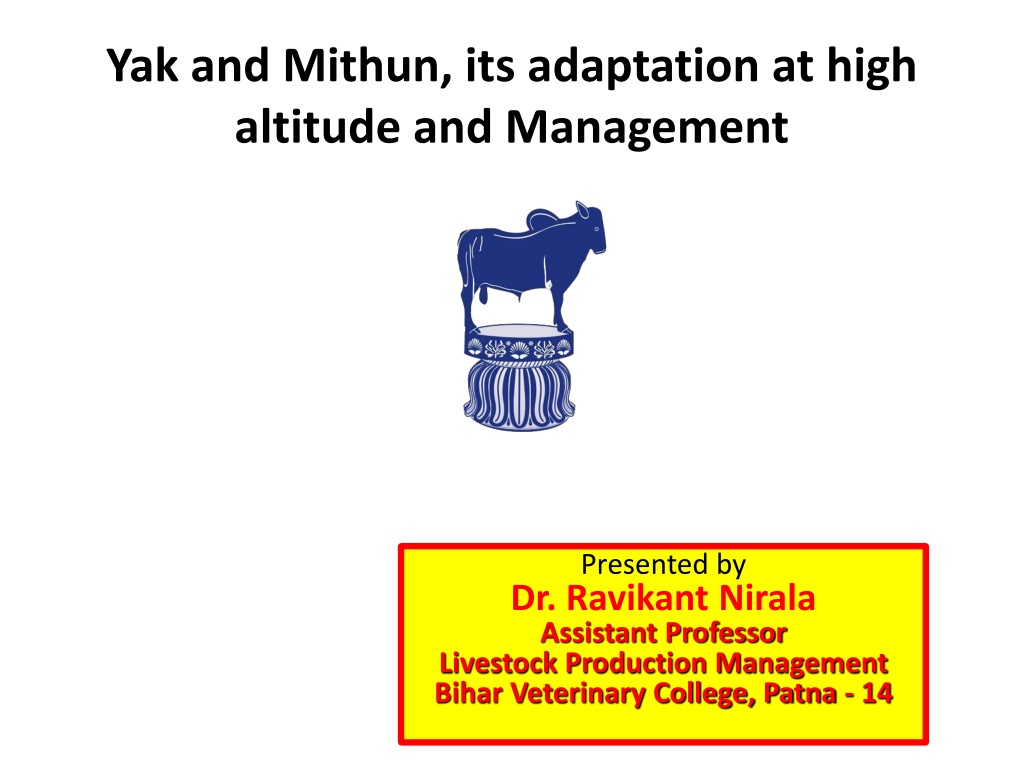Adaptation of Yak and Mithun at High Altitude
Yak and Mithun are domesticated bovids known for their adaptation to high altitudes in the Himalayan region. Yaks, descended from wild yaks, are used for various purposes like transportation, climbing, and trekking. They have specific mating behaviors and unique anatomical modifications for high altitude survival, such as sturdy legs and dense fur. Mithun, closely related to yaks, also thrives in high altitude regions, providing various products for local communities.
Download Presentation

Please find below an Image/Link to download the presentation.
The content on the website is provided AS IS for your information and personal use only. It may not be sold, licensed, or shared on other websites without obtaining consent from the author.If you encounter any issues during the download, it is possible that the publisher has removed the file from their server.
You are allowed to download the files provided on this website for personal or commercial use, subject to the condition that they are used lawfully. All files are the property of their respective owners.
The content on the website is provided AS IS for your information and personal use only. It may not be sold, licensed, or shared on other websites without obtaining consent from the author.
E N D
Presentation Transcript
Yak and Mithun, its adaptation at high altitude and Management Presented by Dr. Ravikant Nirala Assistant Professor Livestock Production Management Bihar Veterinary College, Patna - 14
Position in Animal kingdom Kingdom: Animalia Phylum: Class: Order: Family: Genus: Species: Chordata Mammalia Artiodactyla Bovidae Bos Bos gruniens (YAK) Bos frontalis (MITHUN)
General Characteristics of Yak Yak is a long-haired domesticated bovid found throughout the Himalayan region of the Indian subcontinent. It is also found in the Myanmar, Yunnan, Sichuan as Mongolia and Siberia. It is descended from the wild yak (Bos mutus) and closely related to bison. Yak is known as grunting ox, however in bovine lowing (mooing) sound. It is originated from Bos mutus ("mute ox"). It is a beast of burdens at high altitude for transport across mountain passes for local farmers and traders as well as for climbing and trekking expeditions. Their products like milk, fibres, meat and fuel are utilised. Males weigh 350 to 585 kg females weigh 225 to 255 kg. Yaks are heavily built animals with a bulky frame. Wild yaks can be substantially heavier, bulls reaching weights of up to 1,000 kg depending on the breed. Tibetan and Plateau, as Northern north far
This likely allows them to consume greater quantities of low-quality food at a time, and to ferment it longer so as to extract more nutrients. Yak consume the equivalent of 1% of their body weight daily while cattle require 3% to maintain condition. Yaks mate in the summer, typically between July and September, depending on the local environment. During rut, they become aggressive and regularly fight among each other to establish dominance. The males wallow in dry soil during the rut, often while scent-marking with urine or dung. Females enter estrus up to four times a year and females are receptive only for a few hours in each cycle. It s successful crosses have also been recorded between yak and American bison,gaur, and banteng, generally with similar results to those produced with domestic cattle.
Anatomical modification for adaptation at high altitude Yak having sturdy legs, rounded cloven hooves, and extremely dense, long fur that hangs down lower than the belly. Wild yaks are generally dark, blackish to brown in colouration, while domestic yaks can be quite variable in colour, often having patches of rusty brown and cream. They have small ears and a wide forehead, with smooth horns that are generally dark in colour. In males (bulls), the horns sweep out from the sides of the head, and then curve forward. They typically range from 19 to 39 inches in length and 44 54 inches in height at the withers, while females height are 41 46 inches. The horns of females (cows) are smaller, 11 to 25 inches in length and have a more upright shape. Both sexes have a short neck with a pronounced hump over the shoulders, although this is larger and more visible in males. The rumen of yaks is unusually large, relative to the omasum.
Both sexes have long shaggy hair with a dense woolly undercoat over the chest, flanks, and thighs to insulate them from the cold. Especially in bulls, this may form a long "skirt" that can reach the ground. The tail is long and horse like rather than tufted like the tails of cattle or bison. Their colour vary from white, grey, brown, roan or piebald. The udder the scrotum in males are small and hairy, as protection against the cold. Females have four teats. Gestation lasts between 257 and 270 days, in females and
Physiological modification for adaptation at high altitude Yak physiology is well adapted to high altitudes, having larger lungs and heart than cattle found at lower altitudes. Greater capacity for transporting oxygen through fetal hemoglobin in their blood due to its persistence of throughout their life. They have trouble thriving at lower altitudesand are prone to suffering from heat exhaustion above about 15 C (59 F). Further adaptations to the cold include a thick layer of subcutaneous fat and an almost complete lack of functional sweat glands Compared with domestic cattle.
General Characteristics of Mithun Gayal (Bos frontalis), also known as mithun in Myanmar, is a domestic bovine often called cattle of the mountains distributed in India, Bangladesh, Bhutan and in Yunnan, China. originated matrilinealy from gaur, zebu and cattle. It is rare cattle species reared in the subtropical rain forests of Northeastern hilly regions of India. The gayal differs in several important particulars from the gauras it is somewhat smaller, with proportionately shortter limbs, and stands much lower at the withers. The ridge on the back is less developed and bulls have a larger dewlap on the throat. Northeast
The head is shorter and broader, with a perfectly flat forehead and a straight line between the bases of the horns. The thick and massive horns are less flattened and much less curved than in the gaur, extending almost directly outwards from the sides of the head and curving somewhat upwards at the tips, but without any inward inclination. Their extremities are thus much farther apart than in the gaur. The female Gayal is much smaller than the bull and has scarcely any dewlap on the throat. The skin colour of the head and body is blackish-brown in both sexes and the lower portion of the limbs are white or yellowish. The horns are of uniform blackish tint from base to tip. Some domesticated Gayals are Parti-coloured, while others are completely white.
It was domesticated from wild gaur. It is a hybrid descendant from crossing of wild gaur and domestic cattle, either Bos indicus and Bos taurus. Gayals are essentially inhabitants of hill-forests. In India, semi-domesticated gayals are kept by several ethnic groups of Tripura, Mizoram, Pradesh, Manipur and Nagaland. They also occur in the Chittagong Hill Tracts of Bangladesh and Himalyan tracts of China. living in the hills Assam, Arunachal
In northern Burma, they occur in the kachin and in adjacent Yunnan are found only in the Trung, China and Salween river basins. with yaks and sheep being predominant species until recently, the mithun, or gayal (Bos frontalis) is the most prominent animal exploited by Eastern Himalayan groups. The Mithun is a semi-domesticate, managed in fenced tracts of forests rather than being kept in or near villages. Mithun are primarily imported for the purpose of cross- breeding with other bovids, for example in Bhutan. In Nagaland, the animals are kept semi-wild, and live in herds, being watched over by special caretakers assigned by the villages or the owner of the herd.
Mithuns are wild and each family has a very indigenous marking as a cut on the ear. Gayals play an important role in the social life of the people in Arunachal Pradesh. Marriages are not fixed until the bridegroom's family gives at least one gayal to the bride's household. In Manipur, it is called Sial, Siel, Se/Sia amongst the tribes of the Chin-Kuki-Mizo. The National Research Centre on Mithun is established at Jharnapani, Dimapur, Nagaland under the ICAR
It has similar genetic make-up as the zebu and African taurine cattle capable of withstanding very high temperatures. The mithun is a sturdy animal capable of surviving in difficult hilly terrains with very less or negligible human inputs. Mithun population in India is 2.64 lakh, out of which 82% have been found in Arunachal Pradesh alone. The milk of Mithun is less in quantity but is dense and nutritious as compared to cow or buffalo milk. Due to its high protein and fat, the milk is used for preparing curd, ghee, cheese and sweets. The tribal communities of North East India rear mithun primarily for its meat value. Thus, Mithun is a sacrificial animal and its meat is preferred in comparison to other livestock in North East.
Common terminology associated with Yak and Mithun Species: Bos Adult male: Bull Adult female: Cow Young born male/ female : Calf Young female upto 3 yrs: Heifer Gestation period: 266 days Age of Maturity: 36-45 months Castrated male: Ox Castrated female: Spayed Female with offspring: Suckling Young weaned calves: Weanling Act of Parturition: Calving Sound: Grunt Meat of Yak: Beef Breeding life 20 years Estrous length: 21 days Estrous Period: 2 days Normal temp.: 101.3 F Male: Female= 1:20 RR: 22 HR: 35 Av. Productive life: 20-25 yrs. Act of mating: Mating Volume of Semen: 5 -10 ml Sperm count: 300 million/CC Best breeding season: Spring























